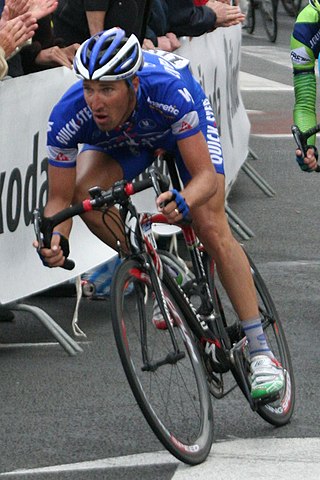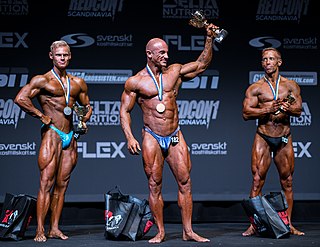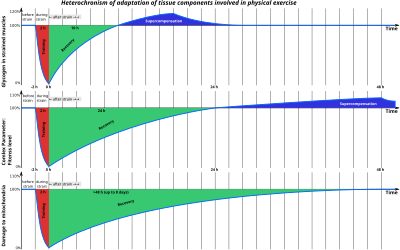
Bodybuilding is the use of progressive resistance exercise to control and develop one's muscles by muscle hypertrophy for aesthetic purposes. It is distinct from similar activities such as powerlifting because it focuses on physical appearance instead of strength. An individual who engages in this activity is referred to as a bodybuilder.

Aerobic exercise is physical exercise of low to high intensity that depends primarily on the aerobic energy-generating process. "Aerobic" is defined as "relating to, involving, or requiring oxygen", and refers to the use of oxygen to meet energy demands during exercise via aerobic metabolism adequately. Aerobic exercise is performed by repeating sequences of light-to-moderate intensity activities for extended periods of time. Aerobic exercise may be better referred to as "solely aerobic", as it is designed to be low-intensity enough that all carbohydrates are aerobically turned into energy via mitochondrial ATP production. Mitochondrion are organelles that rely on oxygen for the metabolism of carbs, proteins, and fats. Aerobic exercise causes a remodeling of mitochondrial cells within the tissues of the liver and heart.
Jack Tupper Daniels is an exercise physiologist, running coach and a coach of Olympic athletes. On March 21, 2013, he was named the head coach of the Wells College men's and women's cross country programs. He received his doctoral degree in exercise physiology at the University of Wisconsin–Madison. Named "The World's Best Coach" by Runner's World magazine, he led SUNY Cortland runners to eight NCAA Division III National Championships, 31 individual national titles, and more than 130 All-America awards. Daniels outlined his training philosophies in the 1998 book, Daniels' Running Formula. He mentors and coaches some of America's top distance runners in the country.

Physical fitness is a state of health and well-being and, more specifically, the ability to perform aspects of sports, occupations and daily activities. Physical fitness is generally achieved through proper nutrition, moderate-vigorous physical exercise, and sufficient rest along with a formal recovery plan.
High-intensity training (HIT) is a form of strength training popularized in the 1970s by Arthur Jones, the founder of Nautilus. The training focuses on performing quality weight training repetitions to the point of momentary muscular failure. The training takes into account the number of repetitions, the amount of weight, and the amount of time the muscle is exposed to tension in order to maximize the amount of muscle fiber recruitment.

Exercise intensity refers to how much energy is expended when exercising. Perceived intensity varies with each person. It has been found that intensity has an effect on what fuel the body uses and what kind of adaptations the body makes after exercise. Intensity is the amount of physical power that the body uses when performing an activity. For example, exercise intensity defines how hard the body has to work to walk a mile in 20 minutes.

Strength training or resistance training involves the performance of physical exercises that are designed to improve strength and endurance. It is often associated with the lifting of weights. It can also incorporate a variety of training techniques such as bodyweight exercises, isometrics, and plyometrics.

High-intensity interval training (HIIT) is a training protocol alternating short periods of intense or explosive anaerobic exercise with brief recovery periods until the point of exhaustion. HIIT involves exercises performed in repeated quick bursts at maximum or near maximal effort with periods of rest or low activity between bouts. The very high level of intensity, the interval duration, and number of bouts distinguish it from aerobic (cardiovascular) activity, because the body significantly recruits anaerobic energy systems. The method thereby relies on "the anaerobic energy releasing system almost maximally".
Interval training is a type of training exercise that involves a series of high-intensity workouts interspersed with rest or relief periods. The high-intensity periods are typically at or close to anaerobic exercise, while the recovery periods involve activity of lower intensity. Varying the intensity of effort exercises the heart muscle, providing a cardiovascular workout, improving aerobic capacity and permitting the person to exercise for longer and/or at more intense levels.
Periodization is a cyclical method of planning and managing athletic or physical training and involves progressive cycling of various aspects of a training program during a specific period. Conditioning programs can use periodization to break up the training program into the off-season, preseason, inseason, and the postseason. Periodization divides the year round condition program into phases of training which focus on different goals.
General Physical Preparation, also known as GPP, lays the groundwork for later Specific Physical Preparation, or SPP. In the GPP phase, athletes work on general conditioning to improve strength, speed, endurance, flexibility, structure and skill. GPP is generally performed in the off-season, with a lower level of GPP-maintenance during the season, when SPP is being pursued. GPP helps prevent imbalances and boredom with both specific and non-specific exercises by conditioning the body to work.
General fitness training works towards broad goals of overall health and well-being, rather than narrow goals of sport competition, larger muscles or concerns over appearance. A regular moderate workout regimen and healthy diet can improve general appearance markers of good health such as muscle tone, healthy skin, hair and nails, while preventing age or lifestyle-related reductions in health and the series of heart and organ failures that accompany inactivity and poor diet.

Sports nutrition is the study and practice of nutrition and diet with regards to improving anyone's athletic performance. Nutrition is an important part of many sports training regimens, being popular in strength sports and endurance sports. Sports nutrition focuses its studies on the type, as well as the quantity of fluids and food taken by an athlete. In addition, it deals with the consumption of nutrients such as vitamins, minerals, supplements and organic substances that include carbohydrates, proteins and fats.

Progressive overload is a method of strength training and hypertrophy training that advocates for the gradual increase of the stress placed upon the musculoskeletal and nervous system. The principle of progressive overload suggests that the continual increase in the total workload during training sessions will stimulate muscle growth and strength gain by muscle hypertrophy. This improvement in overall performance will, in turn, allow the athlete to keep increasing the intensity of their training sessions.

Muscle hypertrophy or muscle building involves a hypertrophy or increase in size of skeletal muscle through a growth in size of its component cells. Two factors contribute to hypertrophy: sarcoplasmic hypertrophy, which focuses more on increased muscle glycogen storage; and myofibrillar hypertrophy, which focuses more on increased myofibril size. It is the primary focus of bodybuilding-related activities.

Spot reduction refers to the claim that fat in a certain area of the body can be targeted for reduction through exercise of specific muscles in that desired area. For example, exercising the abdominal muscles in an effort to lose weight in or around one's midsection. Fitness coaches and medical professionals as well as physiologists consider the claim to be disproved.
Nutrient timing is a sports dieting concept which suggests that time may be a missing dimension in improved muscular development. This concept represents a change over the previous school of thought that focused on protein loading without emphasizing the synchronicity between eating and exercising.
The metabolic window is a term used in strength training to describe the 15-minute period after exercise during which nutrition can shift the body from a catabolic state to an anabolic one. Specifically, it is during this period that the intake of protein and carbohydrates can aid in the increase of muscle mass.
The plateau principle is a mathematical model or scientific law originally developed to explain the time course of drug action (pharmacokinetics). The principle has wide applicability in pharmacology, physiology, nutrition, biochemistry, and system dynamics. It applies whenever a drug or nutrient is infused or ingested at a relatively constant rate and when a constant fraction is eliminated during each time interval. Under these conditions, any change in the rate of infusion leads to an exponential increase or decrease until a new level is achieved. This behavior is also called an approach to steady state because rather than causing an indefinite increase or decrease, a natural balance is achieved when the rate of infusion or production is balanced by the rate of loss.
Eccentric training is a type of strength trainingthat involves using the target muscles to control weight as it moves in a downward motion. This type of training can help build muscle, improve athletic performance, and reduce the risk of injury. An eccentric contraction is the motion of an active muscle while it is lengthening under load. Eccentric training is repetitively doing eccentric muscle contractions. For example, in a biceps curl the action of lowering the dumbbell back down from the lift is the eccentric phase of that exercise – as long as the dumbbell is lowered slowly rather than letting it drop.











